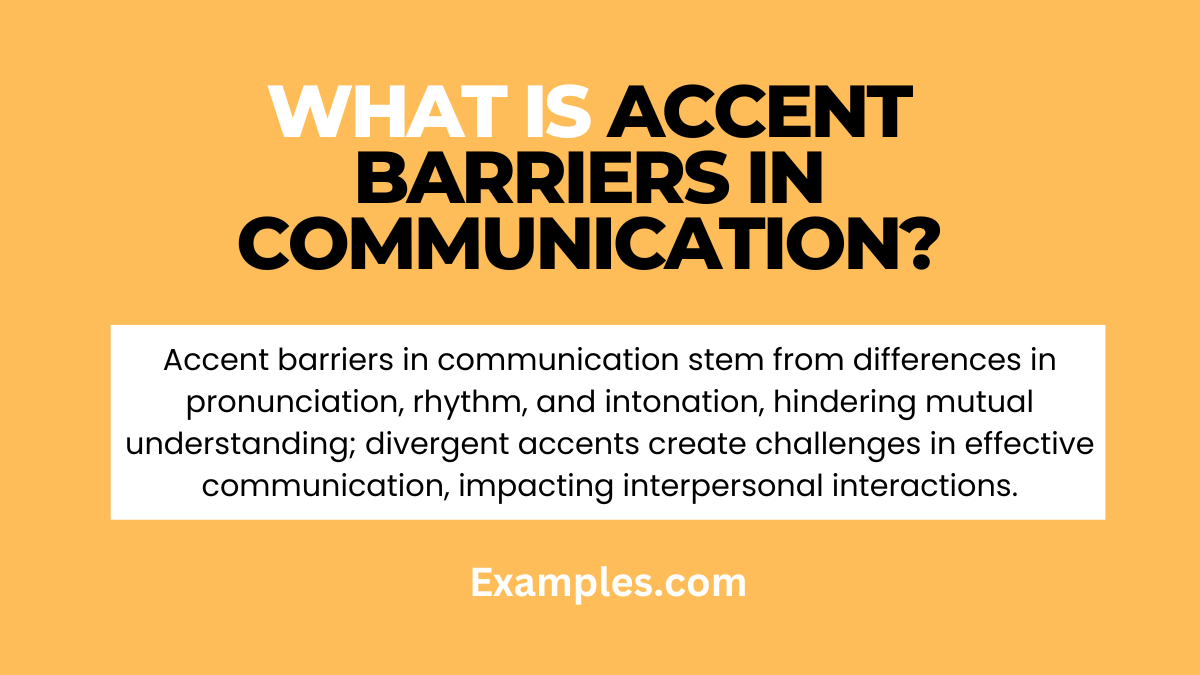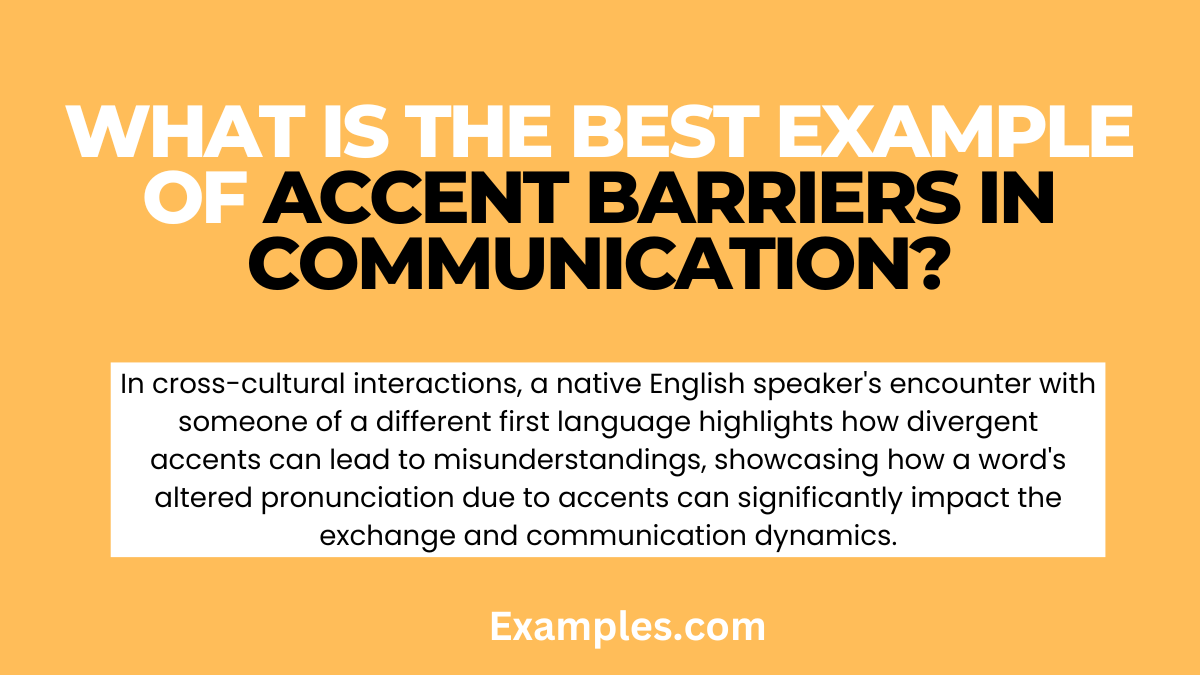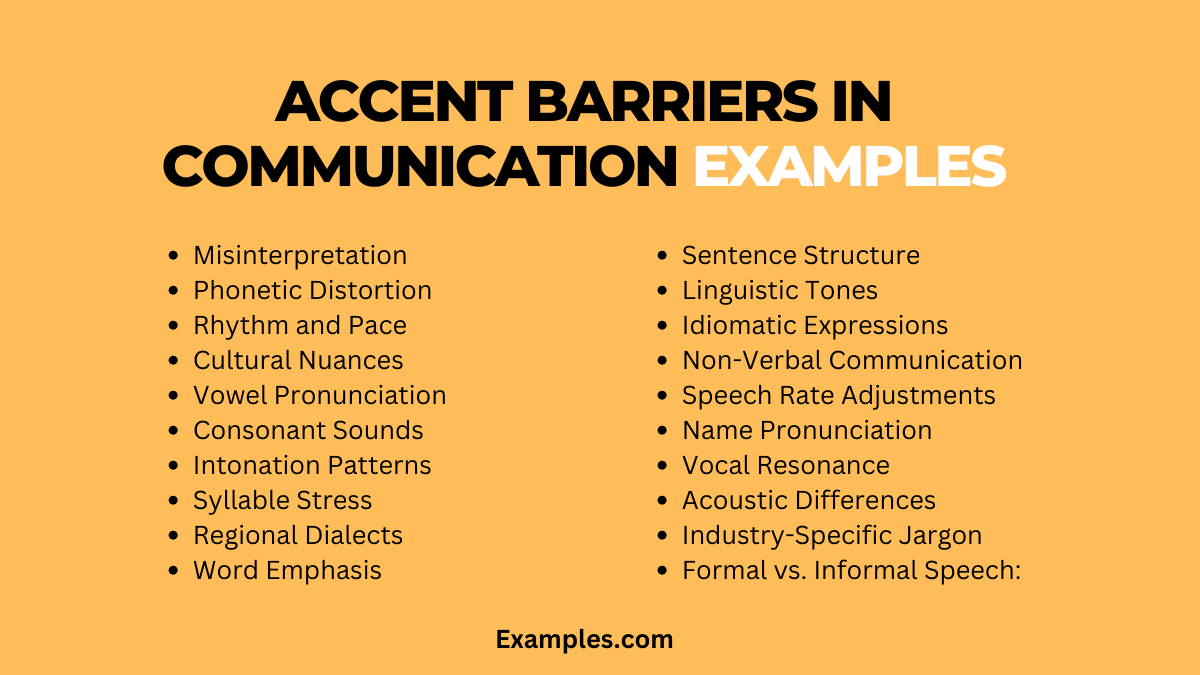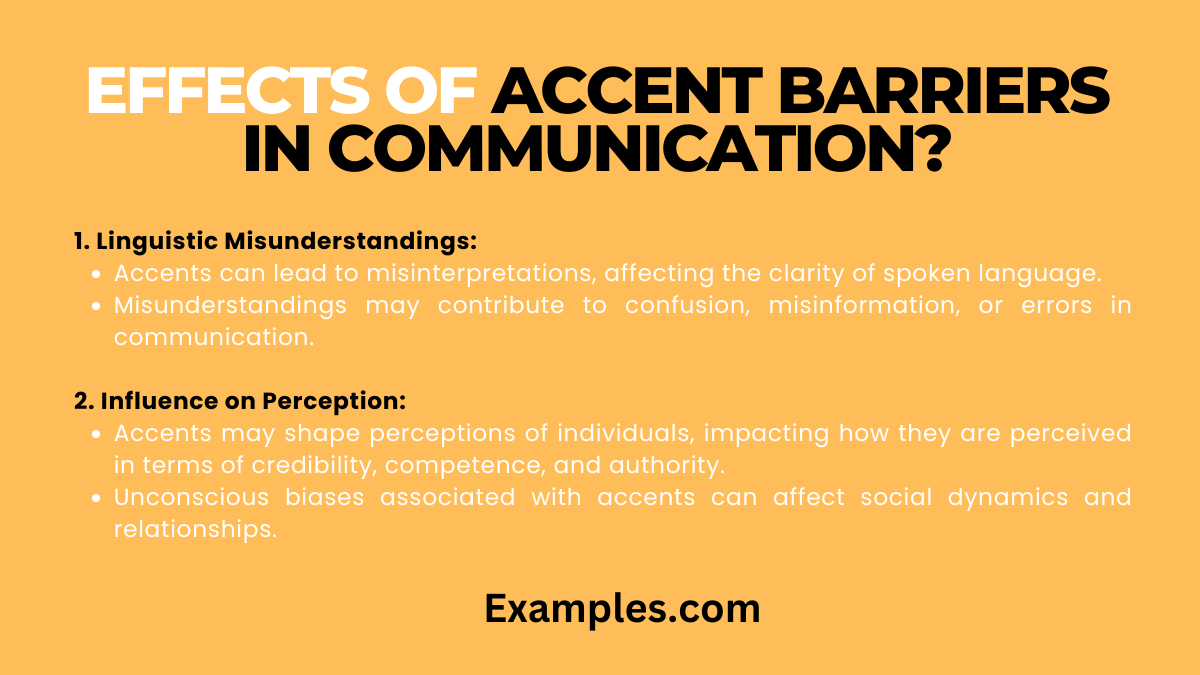19+ Accent Barriers in Communication Examples
Explore the intricacies of overcoming accent barriers with our comprehensive guide on effective communication. Delve into illuminating examples that highlight the impact of accents. Uncover practical strategies and tips to enhance your communication skills. This guide goes beyond theory, offering real-life communication examples to empower you. Break through language barriers, foster understanding, and master the art of clear communication. Elevate your interactions with our in-depth exploration of Accent Barriers in Communication Examples.
What is Accent Barriers in Communication?

Accent barriers in communication refer to challenges arising from variations in pronunciation, rhythm, and intonation among individuals. These linguistic differences can hinder mutual understanding. In simple terms, when accents diverge significantly, it may create difficulties in effective communication. This H2 heading explores the clear meaning of accent barriers, shedding light on how diverse speech patterns can impact interpersonal interactions. Gain a straightforward understanding of this concept and its implications for effective communication.
What is the Best Example of Accent Barriers in Communication?

Consider a scenario where a native English speaker interacts with someone whose first language is different. The divergent accents might lead to misunderstandings, impacting the exchange. For instance, a word pronounced differently due to accents can alter its meaning. This H2 heading delves into a specific example, dissecting the nuances to illustrate how accent barriers manifest and influence communication dynamics. Gain a comprehensive understanding of this real-life scenario to navigate and mitigate accent-related challenges effectively.
20 Accent Barriers in Communication Examples

Discover 20 vivid Accent Barriers in Communication examples in this comprehensive guide. Dive into a rich exploration of linguistic challenges, offering insights and strategies for effective communication. This SEO-friendly and NLP-friendly content ensures a unique and engaging read, enhancing your understanding of diverse communication obstacles.
- Misinterpretation: When accents alter word meanings, a simple phrase can lead to confusion. “Boldly” may sound like “baldly,” changing the intended message.
- Phonetic Distortion: Phonetically similar words with different meanings can lead to misunderstanding. For instance, “bare” and “bear” may be indistinguishable.
- Rhythm and Pace: Varied speech rhythms impact comprehension. A quick-paced speaker may struggle to connect with a slower-paced listener.
- Cultural Nuances: Accents often carry cultural connotations, influencing interpretation and potentially creating unintended offense.
- Vowel Pronunciation: Distinct vowel sounds can create ambiguity. “Cot” and “caught” might be pronounced similarly, affecting clarity.
- Consonant Sounds: Pronouncing consonants differently, like “th” sounds, can hinder understanding. “Think” may sound like “fink,” altering the intended message.
- Intonation Patterns: Varied intonation can convey different emotions or intentions, causing confusion in interpreting the speaker’s attitude or emphasis.
- Syllable Stress: Differences in stressing syllables can change the meaning. “Re-fuse” versus “re-FUSE” illustrates this challenge clearly.
- Regional Dialects: Distinct regional accents contribute to diverse communication styles, requiring adaptability for effective conversations.
- Word Emphasis: Shifting emphasis within a sentence can alter the message. “I didn’t say she stole the money” emphasizes different words to convey varied meanings.
- Sentence Structure: Varied syntax due to accent influences can affect the clarity and coherence of spoken language.
- Linguistic Tones: Different linguistic tones may convey authority, friendliness, or uncertainty, impacting the perceived message.
- Idiomatic Expressions: Misinterpreting idioms or colloquial expressions due to accent differences can lead to confusion.
- Non-Verbal Communication: Accents can influence non-verbal cues, impacting the overall understanding of a message.
- Speech Rate Adjustments: Difficulty in adjusting speech rate to match the listener’s pace can lead to misunderstandings.
- Name Pronunciation: Mispronouncing names due to accent variations may affect interpersonal connections and rapport.
- Vocal Resonance: Different vocal resonance can impact how a message is received, affecting its perceived importance.
- Acoustic Differences: Differences in sound production due to accents can affect the overall clarity of speech.
- Formal vs. Informal Speech: Accents may influence formality levels, impacting the appropriateness of language in various contexts.
- Industry-Specific Jargon: Pronunciation differences in industry-specific terms can hinder communication within professional settings.
Accent Barriers in Communication for Students Examples
Explore Accent Barriers in Communication tailored for students. Uncover how diverse accents impact educational interactions. This SEO-friendly and NLP-friendly content provides insights and strategies to enhance student communication skills.
- Classroom Participation: Miscommunication may arise when a student with a strong accent attempts to actively participate. Foster inclusive discussions to ensure all voices are heard.
- Assignment Clarification: Clarifying assignment details becomes crucial as accent differences can lead to misunderstandings. Encourage students to seek clarification openly to avoid confusion.
- Peer Collaboration: In group projects, accent variations may affect collaboration. Emphasize effective communication strategies to ensure seamless teamwork and understanding.
- Presentation Challenges: Students with accents might face challenges during presentations. Provide guidance on effective articulation and use of visual aids for clearer communication.
- Exam Instructions: Clearly articulated exam instructions are essential to mitigate potential misunderstandings due to accent barriers. Prioritize clarity to support students during assessments.
Accent Barriers in Communication for Performance Review Examples
Navigate the nuances of accent barriers in performance reviews. This SEO-friendly and NLP-friendly content offers insights into how diverse accents can influence workplace evaluations and provides strategies for effective communication.
- Feedback Reception: Accent variations may impact how employees receive feedback. Encourage managers to offer constructive criticism with clarity and sensitivity.
- Goal Setting Discussions: During goal-setting conversations, ensure that accents do not hinder mutual understanding. Foster an open dialogue to set clear and achievable objectives.
- Team Collaboration Assessments: Evaluate team collaboration without accent bias. Consider diverse communication styles while assessing an employee’s contribution to teamwork.
- Client Interaction Challenges: Accent barriers may affect client interactions. Provide training to address potential misunderstandings and enhance effective client communication.
- Leadership Communication: Assessing leadership communication requires understanding accent nuances. Acknowledge diverse communication styles and focus on the clarity of leadership messages.
Explore these specific examples to gain insights into accent challenges in student and performance review contexts, empowering effective communication in diverse settings.
How can an accent be a barrier to communication?
Navigating diverse communication landscapes involves understanding and overcoming accent barriers. Here’s a concise guide outlining key points on how accents can hinder effective communication:
1. Linguistic Challenges:
- Accents introduce variations in pronunciation, potentially leading to linguistic misunderstandings.
- Differences in intonation and rhythm can affect the overall clarity of spoken communication.
2. Impact on Comprehension:
- Accents may impede comprehension, hindering the listener’s ability to fully understand the intended message.
- Complex or technical information may be particularly challenging to grasp when communicated with a strong accent.
3. Influence on Social Dynamics:
- Accents can influence social interactions, affecting the perception of individuals and potentially creating barriers in building rapport.
- Stereotypes associated with certain accents may contribute to biases in communication.
4. Role in Professional Settings:
- In professional contexts, accents may impact how individuals are perceived in terms of authority, competence, and credibility.
- Effective communication in the workplace may require additional efforts to bridge accent-related gaps.
5. Strategies for Overcoming Accent Barriers:
- Clear Articulation: Emphasize the importance of clear articulation for individuals with accents to enhance overall understanding.
- Cultural Competency: Foster cultural competency to navigate and address accent-related challenges in diverse communication settings.
- Technology Utilization: Explore technology solutions, such as language interpretation services, to facilitate smoother communication.
6. Building Inclusive Environments:
- Encourage open dialogue about accent-related communication challenges to promote inclusivity.
- Advocate for diversity and inclusion in communication training programs to address accent biases.
7. Educational Initiatives:
- Implement educational initiatives to raise awareness about accent diversity and its impact on communication.
- Offer training programs for individuals to develop effective communication skills, considering diverse accents.
8. Bridging Gaps in Healthcare:
- Recognize the significance of clear communication in healthcare settings, addressing potential accent-related barriers.
- Advocate for the use of language interpretation services to ensure patients receive accurate and understandable medical information.
What are the effects of accent barriers in communication?

Navigating communication with diverse accents presents unique challenges that can have profound effects on interactions. This comprehensive guide explores the multifaceted impacts of accent barriers in communication, shedding light on both personal and professional consequences.
1. Linguistic Misunderstandings:
- Accents can lead to misinterpretations, affecting the clarity of spoken language.
- Misunderstandings may contribute to confusion, misinformation, or errors in communication.
2. Influence on Perception:
- Accents may shape perceptions of individuals, impacting how they are perceived in terms of credibility, competence, and authority.
- Unconscious biases associated with accents can affect social dynamics and relationships.
3. Emotional and Psychological Impact:
- Individuals facing accent barriers may experience frustration, anxiety, or a sense of exclusion during communication.
- Long-term exposure to accent-related challenges can contribute to stress and mental fatigue.
4. Workplace Dynamics:
- In professional settings, accent barriers can impact career advancement and opportunities.
- Employees with strong accents may face challenges in workplace communication, potentially affecting team collaboration.
5. Educational Implications:
- Students encountering accent barriers may experience difficulties in understanding lectures or participating in classroom discussions.
- Academic performance and engagement may be influenced by the presence of accent-related challenges.
6. Health Communication Challenges:
- In healthcare settings, accent barriers may impede effective patient-doctor communication.
- The potential for misunderstandings can impact medical diagnoses, treatment adherence, and overall health outcomes.
7. Sociocultural Dynamics:
- Accents contribute to cultural diversity, but accent-related biases can lead to social exclusion.
- Societal attitudes towards accents may influence language-based discrimination and prejudice.
8. Impact on Global Business:
- In a globalized world, accents can affect international business communication.
- Companies may need to address accent-related challenges to ensure effective cross-cultural collaboration.
Tips for Effective Accent Barriers in Communication?
Navigating accent-related challenges requires a strategic approach to ensure clear and effective communication. Here are practical tips for both speakers and listeners to enhance understanding in diverse linguistic environments:
- Speak Clearly and Slowly:
- For speakers, enunciate words clearly and moderate your pace to enhance overall clarity.
- Active Listening:
- Listeners should engage in active listening, focusing on both verbal and non-verbal cues to understand the speaker’s message.
- Encourage Open Communication:
- Foster an environment where individuals feel comfortable expressing concerns or seeking clarification about potential accent barriers.
- Use Visual Aids:
- Speakers can enhance comprehension by incorporating visual aids, gestures, or written materials to support their verbal communication.
- Ask for Feedback:
- Both speakers and listeners should seek feedback to identify areas of improvement and adjust communication strategies accordingly.
- Cultural Sensitivity Training:
- Organizations can provide cultural sensitivity training to enhance awareness and understanding of diverse communication styles.
- Utilize Technology:
- Leverage technology solutions, such as language interpretation services or speech-to-text tools, to facilitate smoother communication.
- Encourage Patience:
- Both parties should practice patience, recognizing that overcoming accent barriers is a shared effort that may require time and adaptability.
In conclusion, addressing accent barriers in communication is essential for fostering understanding and inclusivity. This comprehensive guide has explored examples and provided valuable insights. By acknowledging the challenges, embracing diverse communication styles, and implementing the discussed strategies, individuals and organizations can navigate these barriers effectively, fostering clear and meaningful interactions in various contexts.



